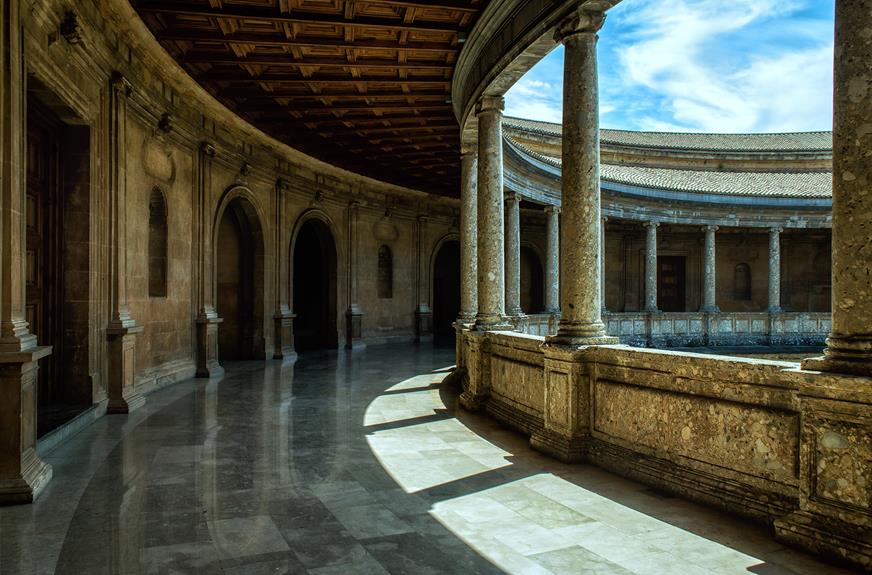
As I explore Spain's rich history, my senses are overwhelmed by the echoes of the past. Roman ruins rise from the earth, telling tales of ancient conquests. Moorish architectural marvels stand tall, showcasing the fusion of cultures. Prehistoric sites unveil the secrets of our ancestors through vibrant cave paintings. Medieval castles and fortresses guard stories of knights and kings. And ancient Roman and Greek theatres transport me back in time, where I can almost hear the applause of the audience. Come with me as we uncover Spain's ancient historical gems.
Key Takeaways
Table of Contents
- Roman ruins in Spain provide valuable insights into the past
- Moorish architecture in Spain showcases the brilliance of Islamic influences
- Prehistoric sites and cave paintings offer unique insight into the lives and culture of our ancestors
- Medieval castles and fortresses hold significant historical significance and transport us back in time.
Roman Ruins in Spain
I frequently visit Roman ruins in Spain to uncover the rich historical gems they hold. These ancient sites not only captivate me with their grandeur, but also provide valuable insights into the past. One aspect that particularly fascinates me is the ongoing archaeological excavations taking place at these ruins. These excavations allow us to peel back the layers of time and discover hidden treasures buried beneath the surface. The meticulous work of archaeologists reveals the lives and stories of the people who once walked these ancient streets. Additionally, preservation efforts play a crucial role in ensuring that these historical sites are protected and accessible for future generations. Through careful restoration and maintenance, these ruins can continue to stand as a testament to the incredible civilization that once thrived in Spain.
Moorish Architectural Marvels
Regularly exploring Roman ruins in Spain, I am always captivated by the Moorish architectural marvels that have left an indelible mark on the country's history. The Islamic influences in Spain are evident in the intricate designs and exquisite craftsmanship of these structures. One such masterpiece is the Alhambra Palace in Granada. This breathtaking palace complex showcases the brilliance of Moorish architecture, with its stunning courtyards, intricate tilework, and soothing water features. Walking through the halls and gardens of the Alhambra, one can't help but be transported back in time to the era of the Moors in Spain. The attention to detail and the harmonious blending of nature and architecture make the Alhambra a true marvel of Islamic art and a must-visit destination for anyone interested in Spain's rich historical heritage.
Prehistoric Sites and Cave Paintings
Exploring Spain's ancient historical gems, I am fascinated by the prehistoric sites and cave paintings that provide a glimpse into the country's distant past. These remarkable artifacts and ancient burial sites offer a unique insight into the lives and culture of our ancestors. Here are three notable examples:
- Altamira Cave: Known as the "Sistine Chapel of prehistoric art," this cave in northern Spain is adorned with stunningly detailed paintings of animals, including bison and horses. These masterpieces date back over 14,000 years, showcasing the artistic skills of early humans.
- Dolmen de Menga: Located in Antequera, this megalithic monument is an impressive burial site from the Neolithic period. Consisting of huge stone slabs, it highlights the ancient people's knowledge of architecture and their reverence for the deceased.
- Tito Bustillo Cave: Situated in Asturias, this cave is renowned for its intricate rock art, depicting animals, human figures, and symbols. These paintings, created around 10,000 years ago, provide valuable insights into the spiritual beliefs and daily life of prehistoric communities.
These prehistoric sites and cave paintings allow us to connect with our ancestors and appreciate the rich history of Spain.
Medieval Castles and Fortresses
As I continue my exploration of Spain's ancient historical gems, the medieval castles and fortresses stand as formidable testaments to the country's rich and turbulent past. These architectural marvels are not only stunning in their grandeur but also hold significant historical significance. The preservation of medieval castles is of utmost importance to maintain a connection with our ancestors and to understand the events that shaped our present. These castles served as strategic strongholds, protecting cities and kingdoms from invaders. Their towering walls, imposing towers, and intricate designs are a testament to the craftsmanship and engineering skills of the time. The historical significance of fortresses lies in their ability to transport us back in time, allowing us to envision the battles fought, the lives lived, and the stories that unfolded within their walls.
Ancient Roman and Greek Theatres
I am captivated by the grandeur and historical significance of Spain's ancient Roman and Greek theatres. These architectural wonders transport me back in time, allowing me to imagine the vibrant performances and cultural gatherings that took place centuries ago. Here are three reasons why I find them so fascinating:
- Historical significance: These theatres provide a window into the past, showcasing the rich history of ancient civilizations and their contributions to arts and entertainment.
- Architectural beauty: The meticulous craftsmanship and attention to detail in these structures are awe-inspiring. From the ornate columns to the perfectly designed seating arrangements, every element is a testament to the skill and creativity of the ancient architects.
- Cultural preservation: These theatres serve as a reminder of Spain's cultural heritage and the importance of preserving and celebrating the traditions of the past.
Visiting these ancient Roman and Greek theatres is not only a journey through time but also a chance to appreciate the timeless beauty and cultural significance they hold.
Frequently Asked Questions
Are There Any Roman Ruins in Spain That Have Been Fully Preserved and Can Still Be Explored Today?
Yes, there are fully preserved Roman ruins in Spain that can still be explored today. They hold immense historical and cultural significance, showcasing the architectural marvels of the Roman Empire.
What Were Some of the Major Contributions of Moorish Architectural Marvels to Spain's Cultural and Architectural Heritage?
The Moorish architectural influence in Spain has greatly enriched its cultural and architectural heritage. Additionally, the preservation of Roman ruins in Spain allows for a unique glimpse into the past.
How Have Prehistoric Sites and Cave Paintings in Spain Helped Archaeologists Gain Insights Into the Lives of Early Humans?
Prehistoric cave art techniques and the significance of burial sites in Spain have provided valuable insights into the lives of early humans. These discoveries have helped archaeologists understand their culture, beliefs, and even their artistic expressions.
Can Visitors Access the Interiors of Medieval Castles and Fortresses in Spain, or Are They Mostly Just for External Viewing?
Yes, visitors can access the interiors of many medieval castles and fortresses in Spain. For example, I recently explored the Alhambra in Granada and was amazed by its rich history and stunning architecture.
What Makes Ancient Roman and Greek Theatres in Spain Unique Compared to Other Ancient Theatres Found in Europe?
Ancient Roman and Greek theatres in Spain offer unique features that set them apart from other ancient theatres in Europe. Their architectural design, use of natural landscapes, and rich cultural history make them a must-visit for any history enthusiast.




Leave a Reply
You must be logged in to post a comment.